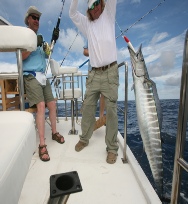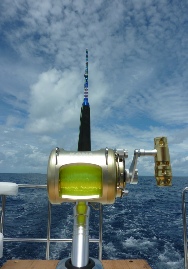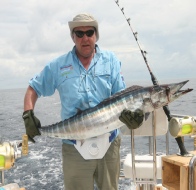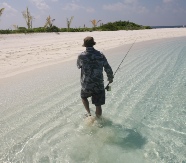© 2014 Gary Smith Fishing Ltd All Rights Reserved










Proudly Associated With


From last time rock, fishing in calm seas, we will move on to a little rougher waters and getting some distance out. The best advice I can give when fishing from rocks is to survey the waters. It is all too easy to get set up and cast out before really studying the area you are fishing in. Try and get up high and have a look for dark patches of rock or weed; this is where the fish are likely to be. The secret here is to cast the bait to the edge of these areas as losing tackle is soul destroying and if you can see a lighter patch of sand in between darker patches of rock and weed then give this a try first. Wrasse and Conger love these areas taking maximum advantage of the available cover to lie in wait. Retrieval can also be a problem as the weight or hooks get caught up. Keep the rod tip high as you reel in. If a higher ledge of rock is available then stand up on it to reel in. Reel in faster than you maybe would in surf, not allowing the terminal tackle chance to be dragged down by the weight into the rocky bottom. When fishing areas such as these a bomb shaped weight is far less likely to get snagged than the rest. Some of these weights are available with a vaned device known as a weight lifter attached to top. This helps the weight lift in the water as it is retrieved. Another option is to use a weak link for your weight, this is a piece of thinner line or a weak clip so when the weight becomes fast the line or clip breaks allowing retrieval of your terminal tackle and hopefully your fish, minus the weight. Also keep hook lengths to the minimum, around twenty centimetres. This will help if weed is prevalent in the area.
If you do get stuck do not under any circumstances continue reeling in thinking the weight will come free. You will break your rod. When the line is tight straighten the rod so there is no tension on the rod rings i.e. the rod is pointing out to sea in line with the main line. Walk slowly backwards until the weight releases or breaks free. If the weight has broken free, wind in slowly, trapping the slack line against the rod with your finger so the line feeds correctly back onto the reel.
Another option for fishing in deeper waters such as these for bigger fish is a form of long lining mixed with a little game fishing. A very good quality main line is required for this. Cast a good sized weight out with a weak link or weak clip attaching it to the main line via a large swivel and soft bead at the reel side of the swivel. A weight of around 130 grams should be enough. Then make up a rig with a 80 centimetre main line and a 20 centimetre line coming off just below halfway. Tie two size 1/0 hooks to the ends and a small but strong swivel with a clip to the other. Take a whole sardine and place the main hook through the mouth from bottom to top and the other in the centre of the back. Clip this to your reel line you have cast out previously. The fish will slide down the line and bob around in the water mimicking an injured fish.
Keep the rod high in the rod rest and watch what is happening as this bait will be attacked by a bigger fish and it will be a hard take. Once the line dips start reeling in. The weight swivel will come up to the clip holding the bait on and then the retrieval of your fish begins. Keep the rod high because the fish will go for cover in the rocks.
As mentioned earlier use a high breaking strain line for this method and heavier reel and rod also.
Copyright © Gary Smith & Luigi Mateos
Back
| Address |
| Contact Us |
